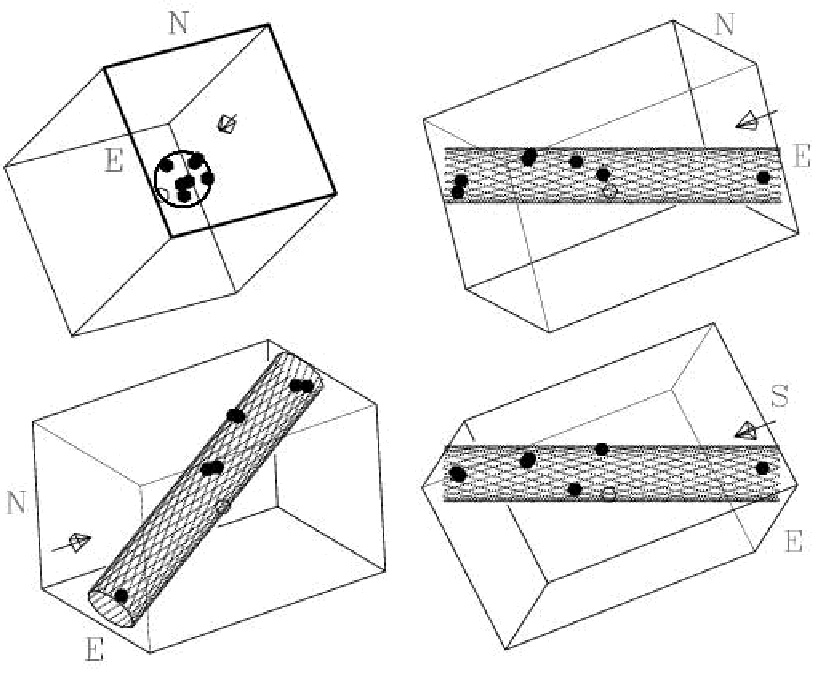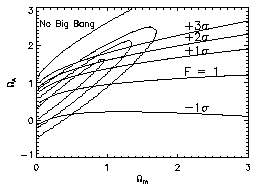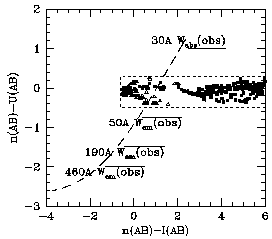2. Why is Lyman alpha selection better?
Two effects work together to make Lyman alpha selection (as
opposed to surveys based on continuum flux selection) particularly
useful for high redshift surveys. (1) Because the line is predicted to
have extremely large equivalent width (Valls-Gabaud 1993,
Charlot & Fall 1993), it is possible to identify
objects which are far below the detection limit of broad band surveys
e.g. surveys based on the Lyman Break technique (Steidel and Hamilton
1992), and (2) as soon as a candidate Lyman alpha emitter has been
confirmed spectroscopically its redshift is also known with high
accuracy.
The volume density of faint galaxies is much higher than the volume
density of the much brighter Lyman Break galaxies (LBGs), and faint
Lyman alpha selected galaxies can therefore very effectively be used
to map out structures in the early universe. The high volume density
and precise redshifts make it possible to easily produce 3D maps of
filaments and other structures in the high redshift universe. To the
right is shown an example of a filament at z=3 mapped by eight Lyman
alpha emitters and viewed from several different perspectives (from
Møller and Fynbo, 2001).
The typical Lyman alpha selected high redshift object is much fainter,
smaller, and less massive than todays fully formed galaxies
(
Fynbo, Møller and Thomsen, 2001). In
numerical simulations of the early universe such low mass clumps are
seen to attract each other, to collide, and finally to merge to build
up larger and larger galaxies. Typical high redshift Lyman alpha
emitters can therefore be seen as the elemental ``galaxy building
blocks'' and we often refer to them as ``LEGOs''.
|
|
 Valls-Gabaud, D., 1993, ApJ, 419, 7 Valls-Gabaud, D., 1993, ApJ, 419, 7
 Charlot, S., & Fall, S.M., 1993, ApJ, 415, 580
Charlot, S., & Fall, S.M., 1993, ApJ, 415, 580
 Steidel and Hamilton, 1992, AJ, 104, 941 Steidel and Hamilton, 1992, AJ, 104, 941

 Møller and Fynbo, 2001, A&A, 372, L57
Møller and Fynbo, 2001, A&A, 372, L57
 Fynbo, Møller and Thomsen, 2001, A&A, 374, 443
Fynbo, Møller and Thomsen, 2001, A&A, 374, 443
 LEGO: Lyman alpha Emitting Galaxy-building
Object LEGO: Lyman alpha Emitting Galaxy-building
Object
|
![]() Scientific aims
Scientific aims  Patridge and Peebles 1967, ApJ, 147, 868
Patridge and Peebles 1967, ApJ, 147, 868  LALA: Rhoads et al. 2000, ApJL 545, 85
LALA: Rhoads et al. 2000, ApJL 545, 85  Stiavelli et al., 2001, ApJL 561, L37
Stiavelli et al., 2001, ApJL 561, L37  Venemans et al. 2002, ApJL 569, L11
Venemans et al. 2002, ApJL 569, L11  Ouchi et al. 2002, astro-ph/0202204
Ouchi et al. 2002, astro-ph/0202204  Fynbo, Møller, Thomsen, Hjorth et al. 2002, astro-ph/0203245
Fynbo, Møller, Thomsen, Hjorth et al. 2002, astro-ph/0203245
 Valls-Gabaud, D., 1993, ApJ, 419, 7
Valls-Gabaud, D., 1993, ApJ, 419, 7  Charlot, S., & Fall, S.M., 1993, ApJ, 415, 580
Charlot, S., & Fall, S.M., 1993, ApJ, 415, 580
 Steidel and Hamilton, 1992, AJ, 104, 941
Steidel and Hamilton, 1992, AJ, 104, 941 
 Møller and Fynbo, 2001, A&A, 372, L57
Møller and Fynbo, 2001, A&A, 372, L57
 Fynbo, Møller and Thomsen, 2001, A&A, 374, 443
Fynbo, Møller and Thomsen, 2001, A&A, 374, 443  LEGO: Lyman alpha Emitting Galaxy-building
Object
LEGO: Lyman alpha Emitting Galaxy-building
Object  Lambda-CDM:
Lambda-CDM: Møller and Fynbo, 2001, A&A, 372, L57
Møller and Fynbo, 2001, A&A, 372, L57

 Weidinger et al., 2002, A&A,
in print, astro-ph/0205425
Weidinger et al., 2002, A&A,
in print, astro-ph/0205425

 Møller and Warren, 1993, A&A, 270, 43
Møller and Warren, 1993, A&A, 270, 43
 Fynbo, Møller and Warren, 1999, MNRAS, 305, 849
Fynbo, Møller and Warren, 1999, MNRAS, 305, 849 Fynbo, Møller, Thomsen, Hjorth et al. 2002, astro-ph/0203245
Fynbo, Møller, Thomsen, Hjorth et al. 2002, astro-ph/0203245
 Fynbo, Møller and Thomsen, 2001, A&A, 374, 443
Fynbo, Møller and Thomsen, 2001, A&A, 374, 443  Visibility plots :
Visibility plots :